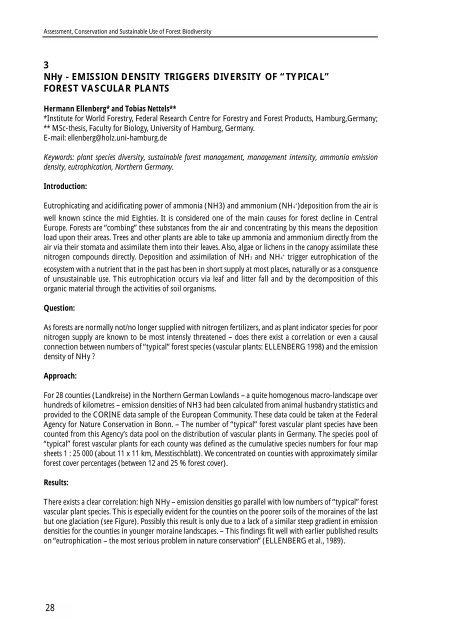Assessment, Conservation and Sustainable Use of Forest Biodiversity
Assessment, Conservation and Sustainable Use of Forest Biodiversity
Assessment, Conservation and Sustainable Use of Forest Biodiversity
Create successful ePaper yourself
Turn your PDF publications into a flip-book with our unique Google optimized e-Paper software.
<strong>Assessment</strong>, <strong>Conservation</strong> <strong>and</strong> <strong>Sustainable</strong> <strong>Use</strong> <strong>of</strong> <strong>Forest</strong> <strong>Biodiversity</strong><br />
3<br />
NHy - EMISSION DENSITY TRIGGERS DIVERSITY OF “TYPICAL”<br />
FOREST VASCULAR PLANTS<br />
Hermann Ellenberg* <strong>and</strong> Tobias Nettels**<br />
*Institute for World <strong>Forest</strong>ry, Federal Research Centre for <strong>Forest</strong>ry <strong>and</strong> <strong>Forest</strong> Products, Hamburg,Germany;<br />
** MSc-thesis, Faculty for Biology, University <strong>of</strong> Hamburg, Germany.<br />
E-mail: ellenberg@holz.uni-hamburg.de<br />
Keywords: plant species diversity, sustainable forest management, management intensity, ammonia emission<br />
density, eutrophication, Northern Germany.<br />
Introduction:<br />
Eutrophicating <strong>and</strong> acidificating power <strong>of</strong> ammonia (NH3) <strong>and</strong> ammonium (NH4 + )deposition from the air is<br />
well known scince the mid Eighties. It is considered one <strong>of</strong> the main causes for forest decline in Central<br />
Europe. <strong>Forest</strong>s are “combing” these substances from the air <strong>and</strong> concentrating by this means the deposition<br />
load upon their areas. Trees <strong>and</strong> other plants are able to take up ammonia <strong>and</strong> ammonium directly from the<br />
air via their stomata <strong>and</strong> assimilate them into their leaves. Also, algae or lichens in the canopy assimilate these<br />
nitrogen compounds directly. Deposition <strong>and</strong> assimilation <strong>of</strong> NH3 <strong>and</strong> NH4 + trigger eutrophication <strong>of</strong> the<br />
ecosystem with a nutrient that in the past has been in short supply at most places, naturally or as a consquence<br />
<strong>of</strong> unsustainable use. This eutrophication occurs via leaf <strong>and</strong> litter fall <strong>and</strong> by the decomposition <strong>of</strong> this<br />
organic material through the activities <strong>of</strong> soil organisms.<br />
Question:<br />
As forests are normally not/no longer supplied with nitrogen fertilizers, <strong>and</strong> as plant indicator species for poor<br />
nitrogen supply are known to be most intensly threatened – does there exist a correlation or even a causal<br />
connection between numbers <strong>of</strong> “typical” forest species (vascular plants: ELLENBERG 1998) <strong>and</strong> the emission<br />
density <strong>of</strong> NHy ?<br />
Approach:<br />
For 28 counties (L<strong>and</strong>kreise) in the Northern German Lowl<strong>and</strong>s – a quite homogenous macro-l<strong>and</strong>scape over<br />
hundreds <strong>of</strong> kilometres – emission densities <strong>of</strong> NH3 had been calculated from animal husb<strong>and</strong>ry statistics <strong>and</strong><br />
provided to the CORINE data sample <strong>of</strong> the European Community. These data could be taken at the Federal<br />
Agency for Nature <strong>Conservation</strong> in Bonn. – The number <strong>of</strong> “typical” forest vascular plant species have been<br />
counted from this Agency’s data pool on the distribution <strong>of</strong> vascular plants in Germany. The species pool <strong>of</strong><br />
“typical” forest vascular plants for each county was defined as the cumulative species numbers for four map<br />
sheets 1 : 25 000 (about 11 x 11 km, Messtischblatt). We concentrated on counties with approximately similar<br />
forest cover percentages (between 12 <strong>and</strong> 25 % forest cover).<br />
Results:<br />
There exists a clear correlation: high NHy – emission densities go parallel with low numbers <strong>of</strong> “typical” forest<br />
vascular plant species. This is especially evident for the counties on the poorer soils <strong>of</strong> the moraines <strong>of</strong> the last<br />
but one glaciation (see Figure). Possibly this result is only due to a lack <strong>of</strong> a similar steep gradient in emission<br />
densities for the counties in younger moraine l<strong>and</strong>scapes. – This findings fit well with earlier published results<br />
on “eutrophication – the most serious problem in nature conservation” (ELLENBERG et al., 1989).<br />
28

















